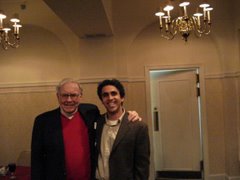Decades of market data, media reports, analyst reports, and more players in the finacial arena has led to a major transformation the investment field. That transformation can be summed up in a single word: activity. To many investors, inactivity is viewed as possessing inferior investment knowledge. To the value investor, inactivity is bliss. To the value investor, activitiy or inactivity is determined by one principle factor: valuation.
The time to be active was October 2008, despite the fact that the market was ultimately headed lower. Further activity was warranted over the subsequent 6 months. Today, the value investor is confronted with the preverbial curse: very little value in the market despite a seemingly unending rise in the S&P 500.
However, sometimes the best investment idea is no investment at all. As the market continues to remain strong, the pool of quality investment opportunities naturally declines. An investor used to action will come to realize that today's investing environment, while appearing friendly to stock prices, may turn out to be his worst enemy. On the other hand, the value-seeking investor understands that short periods of excellent buying opportunities are often followed by longer periods of inactivity. I currently find the market in this longer period.
French mathematician Blaise Pascal observed "all men's miseries derive from not being able to sit in a quiet room alone." Indeed this observation hits the bulls eye when it comes to reasons why many investors make mistakes in investing. Emotion, and the need for immediate active results, often lend themselves to poor investment decisions. Looking back at 2008 and the many investors who failed to make it alive, investors will benefit from the quip, "to finish first, you must first finish."
Indeed while the best gains are off the table for now, sitting still does not necessarily mean being 100% in cash although if thats what it takes, so be it. I'm not inclined to think we are anywhere near that point of 100% cash as certain sectors, like those within the agricultural industry, continue to offer tremendous value on a multi-year basis. However, the time to be 100% invested was a little over a year ago and may not come back for some time.
So, while triple-digit gains may be gone for know, investors can be patient with names like Vodafone a global wireless communications provider. The shares yield nearly 6% and the company owns 45% of Verizon Wireless, the largest wireless provider in the U.S. Currently, Vodafone gets no dividend from VW because its majority owner Verizon Communications is requiring VW to use its cash to pay down debt it owes. Yet, once this debt is repaid later this year, an opportunity exists for Vodafone to begin receiving a nice infusion of dividend cash payments.
While investment opportunities can always be found, the key is to understand when the opportunities are ample, and when the well is dry. This understanding comes from an understanding of fundamental valuation. Further, such understanding has nothing to do with market timing. Every rational investor should expect temporary periods where his portfolio will show a decline, as volatility exists in stock markets. For the value-seeking investor, buying at absolute bottoms and selling at the top is not the key to investment success. Instead its buying assets below intrinsic value, and when no such assets can be bought, then buy nothing
Tuesday, April 13, 2010
Subscribe to:
Post Comments (Atom)


No comments:
Post a Comment